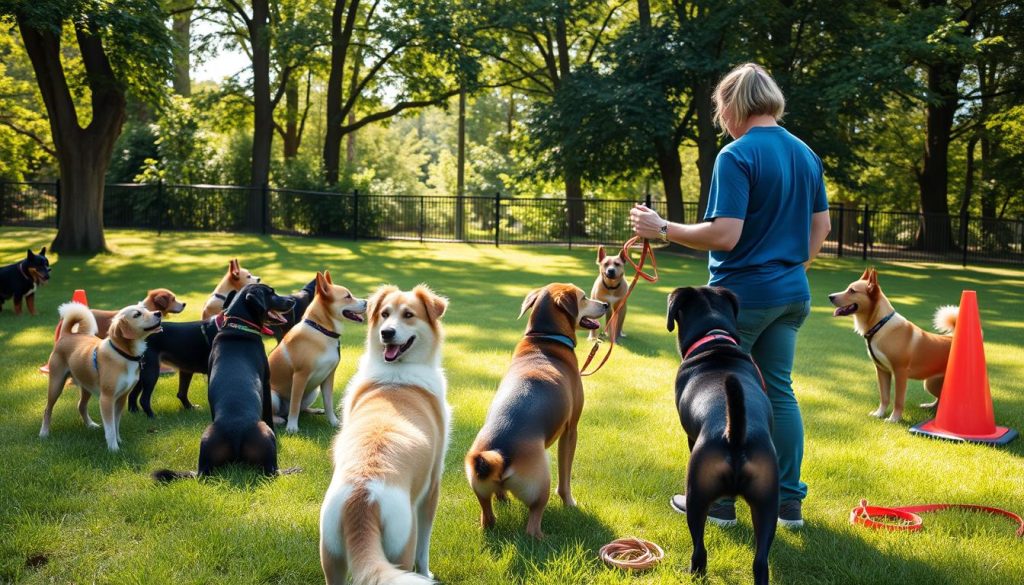Nothing disrupts a peaceful home like a barking dog. As a pet owner, I’ve worked to train my dog to bark less. It’s important to remember that dogs bark naturally. We can’t expect them to be completely silent.
Effective dog training is about understanding your dog, not silencing him. With patience and consistency, I’ve found ways to keep the peace. These training tips for barking dogs have made a big difference, turning noise into quiet companionship.
Key Takeaways
- Understanding the reasons behind barking is the foundation of effective bark control.
- Desensitization is a compassionate and patient method to reduce barking responses.
- Clear commands, like ‘speak’ and ‘quiet’, can enhance communication with your dog.
- Stress-reduction tools may help manage anxiety-driven barking.
- Engaging toys and regular exercise can prevent barking due to boredom or pent-up energy.
- Addressing barking proactively through positive reinforcement reaps long-term quietude.
- When barking is stubborn, professional dog training advice may be beneficial.
Understanding Why Dogs Bark
To stop your dog from barking, you need to understand why they do it. Dogs bark to talk to each other. It’s like how we use words to communicate, but for dogs, barking is their language.
The Nature of Canine Communication
Dogs bark for many reasons. Each bark can mean something different. Knowing this helps you train them better.
They might bark to say hello or to warn of danger. It’s all part of how they interact with the world.
Common Causes of Barking in Dogs
Dogs bark for many reasons. They might bark because they’re excited, scared, or protecting their territory. Understanding what triggers your dog’s barking is key to stopping it.
Some dogs bark more when strangers come by or when they hear strange noises. Knowing these triggers helps you train them better.
Identifying Your Dog’s Barking Triggers
What makes your dog bark can be simple or complex. It could be another dog barking or a scary experience. By watching their behavior, you can figure out what makes them bark.
This knowledge helps you create a training plan that works. It’s all about understanding your dog’s needs and how they communicate.
| Trigger | Description | Outcome |
|---|---|---|
| Strangers | Triggered by unfamiliar faces at or near the home. | Dogs typically bark to alarm about potential threats. |
| Noises | Barks at unfamiliar sounds, especially loud or sudden ones. | This could be alarm barking, a response to being startled or anxious. |
| Isolation | Occurs when the dog is left alone for extended periods. | Commonly associated with separation anxiety, leads to stress-induced barking. |
| Confinement | Barking when confined in a space where movement is restricted. | Usually a sign of frustration or a need for more freedom and activity. |
Creating a training plan that fits your dog’s needs is important. You might use techniques to help them feel less scared or give them more exercise. Each dog is different, so what works for one might not work for another. With patience and observation, you can help your dog feel better and bark less.
Establishing the Right Training Environment
When you start dog training, especially with the quiet command, the right setting is key. A place with few distractions and lots of focus and safety is crucial.
https://www.youtube.com/watch?v=2nfo5SigKWQ
Dog training is more than just commands and treats. It’s about the setting too. I make sure to remove anything that might make your dog bark. Using white noise or privacy screens helps keep your dog calm and focused.
Having control during training is also important. A leash helps keep your dog still and makes teaching them to be quiet easier. When your dog stays quiet, you reward them. This teaches them that being quiet is good, which is a big part of positive training.
| Training Technique | Primary Benefit | Additional Notes |
|---|---|---|
| Sensory Barriers | Blocks external stimuli | Helps focus during positive reinforcement sessions |
| Control via Leash | Manages dog’s movements | Eases the teaching of the quiet command for dogs |
| Environmental Setup | Minimizes distractions | Enhances overall effectiveness of dog training |
Remember, every dog is different. What works for one might not work for another. Tailoring your training to your dog’s needs can make a big difference. It helps your dog learn faster and builds a stronger bond between you and your pet.
Implementing a Desensitization Strategy
Using effective dog training methods like desensitization can really help cut down on unwanted barking. This method slowly gets your dog used to things that make them bark, in a safe way. It’s a key part of bark control techniques, helping to lessen your dog’s anxiety.
The idea is to find out what makes your dog bark a lot. At first, you’ll start with these sounds at a soft level. As your dog gets used to them, you’ll make them louder. You’ll also teach them commands like ‘Stay’, ‘Sit’, ‘Quiet’, and ‘Down’ to help them calm down.
Here’s how to use desensitization in your training tips for barking dogs:
- Find out what noises make your dog bark.
- Start with short sessions of these sounds, then make them longer.
- Slowly make the sounds louder, but not so loud it scares your dog.
- Teach your dog to be quiet with commands like ‘Stay’, ‘Sit’, ‘Quiet’, and ‘Down’.
- Give your dog treats or praise when they’re calm and quiet.
- Keep training up regularly to make calmness a natural thing for your dog.
With consistent and patient training, your dog will learn to see these sounds as good things. This will help them bark less. If your dog’s barking doesn’t get better, you might need to get help from a dog trainer or behaviorist.
| Technique | Purpose | Duration | Frequency |
|---|---|---|---|
| Noise training with controlled exposure | To reduce anxiety and fear response to noises | 10-20 minutes | Daily |
| Obedience training integration | Reinforce calm behavior with commands | 5-15 minutes | Several times a week |
| Volume increment | Gradually accustom to louder noises | Gradual increase over sessions | As tolerated |
| Professional consultation | Address severe anxiety or stagnant progress | Varies | As needed |
By using these bark control techniques together, you can make your home quieter and more peaceful. This will help you and your dog live better together.
Effective Use of Commands in Dog Training
Teaching your dog to understand commands is key to stopping barking. Commands like ‘speak’ and ‘quiet’ help manage barking. This method also strengthens your bond with your dog.
First, teach the ‘speak’ command to show dogs when to bark. Then, use the ‘quiet’ command to stop barking. This teaches dogs to stop barking for rewards like treats or praise. Training can reduce barking by 80%.
- Dogs may learn the ‘speak’ command in the first hour. But, it varies by dog.
- Short, frequent training sessions work better than long ones.
- Start with treats often, then less often, until you don’t need them anymore.
- Teaching dogs to bark only on command can make training easier.
- Keep training patiently as dogs learn faster over time.
Commands help reduce barking and create a disciplined home. Training allows dogs to express themselves in a controlled way. It turns annoying habits into fun tricks.
Teaching the ‘speak’ command is fun and shows off a well-trained dog,” says the AKC Trick Dog Novice checklist.
| Training Phase | Commands Used | Expected Outcome |
|---|---|---|
| Initial Phase | ‘Speak’ Command | Dog learns to bark on cue |
| Second Phase | ‘Quiet’ Command | Dog stops barking on cue |
| Ongoing Reinforcement | Verbal Praise, Hand Signals | Consolidated behavior without treats |
Using both verbal commands and hand signals makes communication better. It ensures your dog understands you in any situation. Also, keep the environment right to prevent barking during training.
How to Train Your Dog Not to Bark with Positive Reinforcement
Teaching your dog when to bark and when to be quiet is key for a peaceful home. Positive reinforcement training is a top choice for this. It works by rewarding your dog for good behavior, making them want to do it again.
Reward-Based Training Techniques
Reward-based training techniques help you and your dog get along better. When your dog is quiet after barking, give them treats or praise. This teaches them that being quiet is good.
Introducing the ‘Quiet’ Command
Teaching your dog the quiet command for dogs is easy and works well if you do it often. First, teach them to ‘speak’, then ‘quiet’. Give them a treat right after they stop barking. This shows them that being quiet gets rewards.
Keep in mind, positive reinforcement training is about encouraging good behavior, not punishing bad. It builds trust and respect, making your pet more obedient and happy. With these methods, you’ll see less barking and a better mood in your dog.
Removing the Triggers That Cause Barking
To stop dogs from barking, we need to know what makes them bark. By reducing what causes them to bark, we can help them behave better. This makes it easier to control their barking.
Things like seeing people or other animals can make dogs bark. To stop this, we can block their view of the outside. Closing curtains or using frosted window films helps a lot.
Teaching dogs to communicate in other ways is also smart. For example, teaching them to ring a bell to go outside is good. It teaches them to behave well and meet their needs.

Also, using white noise or soft music can help. It masks sounds that might scare or alert dogs. This keeps them calm and makes your home quieter.
Here’s a look at some effective ways to manage dog barking:
| Technique | Effectiveness | Notes |
|---|---|---|
| Visual Barriers | High | Reduces visual triggers from outside movement. |
| Alternative Communication | Moderate to High | Replacing barking with other forms of communication like bell ringing. |
| Noise Masking | Moderate | Using white noise or music to dilute disruptive external sounds. |
| Behavioral Rewards | High | Using high-value treats and consistent rewards for quiet behavior. |
Understanding why dogs bark is key to stopping it. It could be because of their environment, mental health, or just habit. By using these methods regularly, you can reduce barking. This makes life with your dog much better.
Using Technology and Tools to Aid in Training
Technology has changed dog training for the better. Tools like anti-stress devices and bark control items help manage bad behaviors. This makes training easier and faster.
Anti-Stress Devices and Their Benefits
Anxiety and stress cause dogs to bark too much. Devices like pheromone collars and anxiety wraps help a lot. They calm dogs naturally, making them ready to learn.
The Role of Bark Control Products
Products like ultrasonic devices and spray collars help dogs not bark too much. Ultrasonic devices use sounds to get a dog’s attention. Spray collars use citronella to stop barking. It’s key to use these tools right and with a vet’s advice.
Let’s look at some stats and products:
| Device | Price | Benefits |
|---|---|---|
| DOGGIE DON’T® Device | $49.95 | Stops barking, jumping, chewing |
| Training Treat & Snack | $14.95 | Made of 100% USDA beef, aids training |
The DOGGIE DON’T® Device is great for fixing dog behaviors. Using these tools helps dogs and keeps peace with neighbors and other pets.
Using new tools and old training methods works well. It’s a mix of technology and traditional training. This helps both dogs and trainers.
Using anti-stress devices or bark control products aims for well-behaved dogs. They keep dogs happy and healthy. So, technology can help you and your dog get along better.
When to Consider Professional Dog Training Help
Many dog owners can handle their pet’s behavior at home. But, sometimes, you might need professional dog training help. If you’ve tried many effective dog training methods and still face issues, it’s time to get professional assistance.
It’s important to understand dog behavior to know when to seek help. Some dogs bark a lot due to anxiety, territorial behavior, or past traumas. These deep-rooted issues often need a professional’s touch.
- Barking due to separation anxiety or excitement when greeting people.
- Barking triggered by boredom or lack of sufficient mental and physical exercise.
- Aggressive or fearful barking that seems unmanageable.
Here are some signs and stats that show when you might need professional help:
| Issue | Statistic | Recommended Action |
|---|---|---|
| High anxiety barking | Causes 30% of the excessive barking cases | Seek behavior modification techniques from professionals |
| Boredom-related barking | Improved in 70% of dogs with the right stimulation | Professional trainers can suggest suitable engagement activities |
| Lack of socialization barking | Common in puppies or rarely socialized dogs | Professional training programs focusing on socialization |

If early training didn’t work or your dog shows signs of distress or aggression, professional dog training can help. They create behavior correction plans that fit your dog’s specific needs.
Getting professional help is not just for convenience. It’s about getting a deeper understanding of dog behavior. Skilled professionals can modify techniques for lasting effective dog training. This not only solves the barking problem but also improves your dog’s overall well-being and behavior.
Conclusion
We’ve explored ways to stop our dogs from barking too much. We’ve looked at different bark control techniques and why dogs bark. This includes barking due to threats or feeling lonely.
Patience and consistency are key. We’ve discussed how to understand what triggers barking and use positive reinforcement. Tools like anti-bark collars can help, but we must always think of our dog’s well-being.
Training dogs to stop barking involves desensitization and distraction. It also means teaching them to obey commands like ‘Quiet’. Some breeds, like Beagles and Terriers, might need more effort. But with the right approach, you can create a peaceful home where your dog’s sweet sounds are heard.


